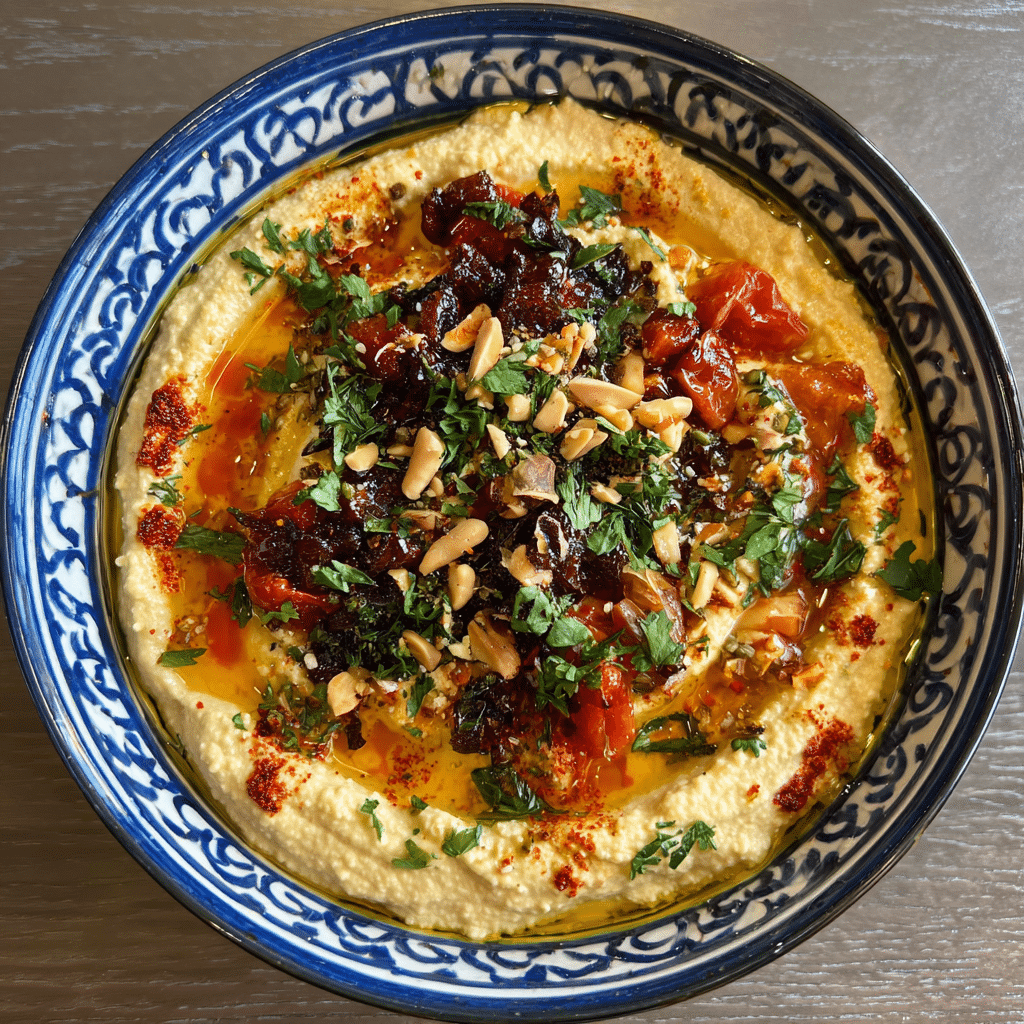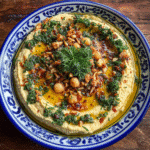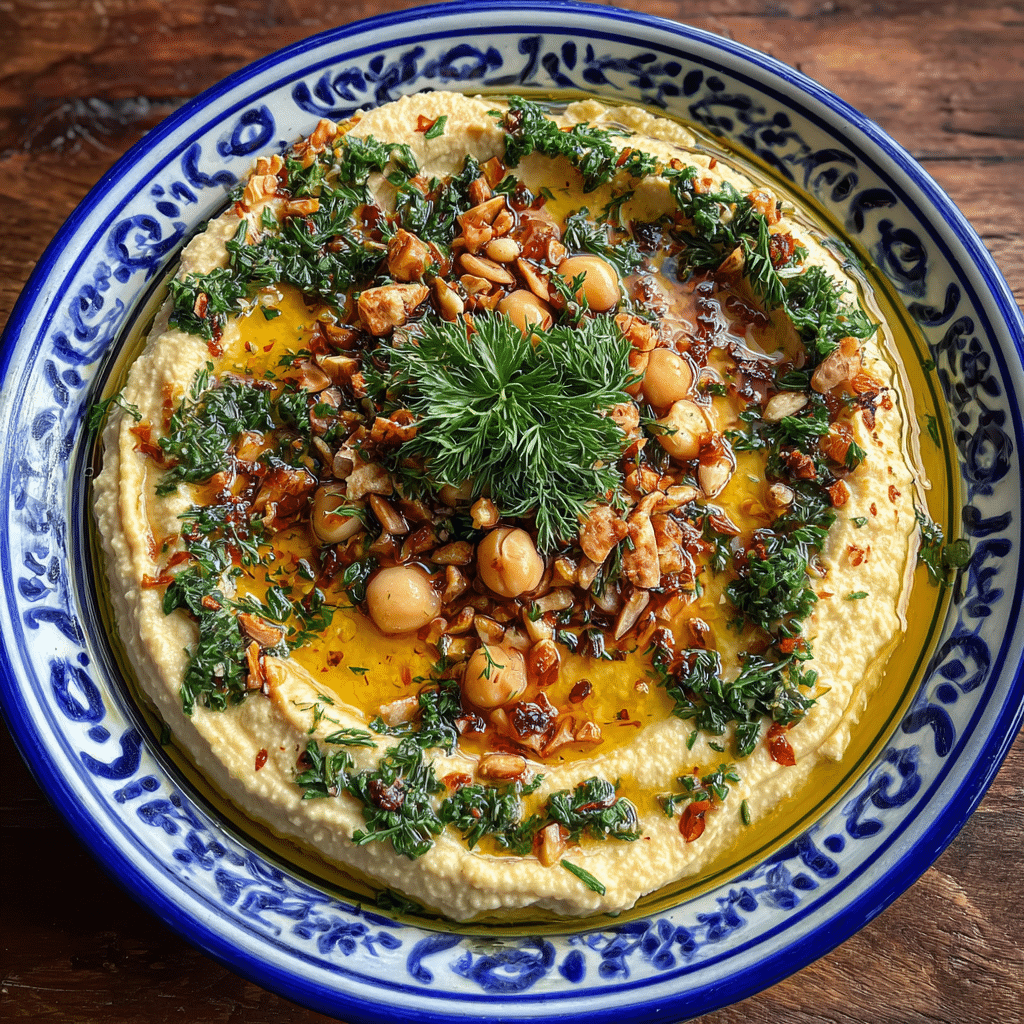Hummus Mediterranean Recipe those three words instantly transport me back to a tiny café in Athens, where I first tasted hummus so silky and flavorful it changed everything I thought I knew about chickpeas. For years, I’d been settling for store-bought versions that were either too grainy, too bland, or oddly bitter. Sound familiar?
Hey there! I’m Emeli, and if you’ve ever wondered why your homemade hummus doesn’t taste like the restaurant version, you’re in the right place. At FoodFansy, I’ve spent countless hours perfecting this Mediterranean staple, and I’m thrilled to share the secrets that transformed my hummus from “meh” to “more, please!”
This hummus Mediterranean recipe delivers that authentic, ultra-creamy texture and bright, balanced flavor you’ve been craving and it takes just 10 minutes to make. Whether you’re meal-prepping for the week, hosting a gathering, or simply want a healthy snack, this recipe never disappoints.
In this guide, I’ll walk you through choosing the best chickpeas, mastering the blending technique, and customizing flavors to suit your taste. Let’s dive in!
Why This Hummus Mediterranean Recipe Works
This hummus Mediterranean recipe has become my go-to for three game-changing reasons:
- Uses simple, affordable ingredients No specialty store trips required; everything you need is likely in your pantry or available at any grocery store
- Ready in 10 minutes flat From chickpeas to creamy dip, this is one of the fastest homemade spreads you’ll ever make
- Incredibly versatile Perfect as a dip, spread, salad dressing base, or even a sandwich filling for packed lunches and dinner parties alike
The magic lies in the technique: proper blending order and adding cold water gradually creates that restaurant-quality, impossibly smooth texture that makes this hummus irresistible.
Choosing the Right Chickpeas for Hummus Mediterranean Recipe
The foundation of exceptional hummus starts with your chickpeas – this choice makes all the difference.
Best Chickpeas for This Hummus Recipe
Canned chickpeas are my weeknight hero convenient, consistent, and perfectly tender. Look for brands with minimal added sodium, and always drain and rinse thoroughly.
Dried chickpeas deliver superior flavor and texture when you have time. Soak them overnight in cold water, then boil until they’re butter-soft (about 1-1.5 hours). The extra effort pays off in noticeably creamier hummus.
Buying Tips for Hummus Mediterranean Recipe
When selecting canned chickpeas, check the expiration date and choose cans without dents. The chickpeas should feel firm through the can, not mushy.
For dried chickpeas, look for uniform size and bright color. Avoid bags with too many broken or discolored beans – fresher is always better.
Pro tip: Many Mediterranean markets sell freshly cooked chickpeas – these are absolute gold for hummus making!
Substitutions
While chickpeas are traditional, you can experiment with white beans (cannellini or butter beans) for a milder, equally creamy dip. The texture will be similar, though the flavor profile shifts slightly sweeter and less nutty.
Ingredients & Prep for Hummus Mediterranean Recipe
Let me walk you through everything you need to create this silky, authentic hummus.
Main Ingredients for Hummus Mediterranean Recipe
- 1 ½ cups cooked chickpeas (or 1 can, drained)
- ¼ cup tahini (sesame seed paste – the secret to authentic flavor)
- 2 tbsp extra virgin olive oil (plus more for drizzling)
- 2 tbsp fresh lemon juice (about 1 lemon)
- 2 cloves garlic (adjust to taste)
- ½ tsp cumin (adds warmth and depth)
- Salt to taste (start with ½ tsp)
- 3–4 tbsp cold water (for that cloud-like texture)
Prep Essentials for Hummus Mediterranean Recipe
If using canned chickpeas: Drain thoroughly and rinse under cold water. Here’s my secret weapon peel the chickpeas by gently rubbing them between your palms. Yes, it takes a few extra minutes, but removing those skins creates noticeably smoother hummus. You don’t need to peel every single one; even removing 75% makes a difference.
If using dried chickpeas: Soak overnight in plenty of cold water (they’ll double in size). Drain, then boil in fresh water until extremely tender – they should squish easily between your fingers. Don’t rush this step; tender chickpeas are everything.
Before you blend: Gather all ingredients and have your food processor or high-speed blender ready. Measure everything out so the process flows smoothly. Fresh lemon juice tastes infinitely better than bottled, so squeeze that lemon right before blending.

Step-by-Step Cooking Instructions for Hummus Mediterranean Recipe
Making perfect hummus is all about technique and order. Here’s how I do it every single time.
Pre-Cooking Prep for Hummus Mediterranean Recipe
Pat your chickpeas completely dry using paper towels or a clean kitchen cloth. Excess moisture dilutes flavor and affects texture.
Peel your garlic cloves and remove the green germ in the center if present (it can taste bitter). If you’re sensitive to raw garlic, you can roast the cloves first for milder, sweeter flavor.
Make sure your tahini is well-stirred the oil separates naturally, so mix it thoroughly before measuring.
Blending Method for Hummus Mediterranean Recipe
Here’s where the magic happens. Add ingredients to your food processor in this specific order:
- Start with tahini and lemon juice. Process for 1-2 minutes until the mixture looks whipped and creamy. This step is crucial!
- Add garlic, cumin, and salt. Process for 30 seconds.
- Add half the chickpeas. Pulse a few times, then process continuously.
- Add remaining chickpeas. Process until broken down.
- With the motor running, slowly drizzle in olive oil.
- Add cold water one tablespoon at a time while processing, until you reach your desired consistency. The hummus should look light, fluffy, and almost mousse-like.
The entire blending process takes about 4-5 minutes. Don’t rush it longer blending creates smoother hummus.
Doneness Check for Hummus Mediterranean Recipe
Your hummus Mediterranean recipe is ready when it has a light, fluffy consistency that’s spreadable but holds its shape. It should not be too thick (paste-like) or too runny (soup-like).
The texture should be completely smooth with no graininess when rubbed between your fingers. If you still feel grittiness, blend for another minute and add a touch more water.
Resting for Hummus Mediterranean Recipe
Transfer your hummus to a container and refrigerate for at least 30 minutes before serving. This resting time is not optional it allows the flavors to meld beautifully, the garlic to mellow slightly, and the texture to firm up perfectly.
When ready to serve, give it a quick stir and taste. Adjust seasoning if needed with more salt, lemon juice, or a drizzle of olive oil.
Pro Tips for Perfect Hummus Mediterranean Recipe
After making hundreds of batches, these are my hard-won secrets for hummus success.
Avoiding Grainy or Bland Hummus Mediterranean Recipe
The peeling trick: While optional, removing chickpea skins creates restaurant-quality smoothness. Make it easier by adding a pinch of baking soda to the boiling water when cooking dried chickpeas – the skins will slip off more easily.
Temperature matters: Cold water creates a lighter, fluffier texture than room temperature water. Some chefs even use ice cubes!
Don’t skip the tahini whipping: Processing tahini with lemon juice first creates an emulsion that makes everything smoother.
Tool Recommendations for Hummus Mediterranean Recipe
A high-powered food processor (at least 7-cup capacity) is my preferred tool. It handles larger batches and creates the smoothest texture.
A high-speed blender (like a Vitamix) also works beautifully, though you may need to stop and scrape down the sides more often.
Immersion blenders don’t work well for hummus they can’t create the same silky texture.
Storage & Reheating for Hummus Mediterranean Recipe
Store hummus in an airtight container in the refrigerator for up to 5-7 days. Pour a thin layer of olive oil over the top before sealing this prevents oxidation and keeps it fresh.
Hummus thickens in the fridge, which is normal. Before serving, let it sit at room temperature for 15 minutes, then stir in a tablespoon of cold water to restore creaminess.
You can freeze hummus for up to 3 months, though the texture may separate slightly upon thawing. Stir well and add fresh lemon juice to revive it.
Flavor Variations for Hummus Mediterranean Recipe
One of the joys of this hummus Mediterranean recipe is how easily it adapts to different flavor profiles.
Spicy Twist for Hummus Mediterranean Recipe
Add 1-2 tsp harissa paste or ½ tsp cayenne pepper to the blend for a fiery kick. For smokiness, try 1 tsp smoked paprika or 1 chipotle pepper in adobo.
Top with chili oil or crushed red pepper flakes when serving for extra heat and visual appeal.
Herb-Infused Hummus Mediterranean Recipe
Blend in ½ cup fresh herbs like parsley, cilantro, or dill for vibrant green hummus. Roasted garlic hummus is divine swap raw garlic for a whole head of roasted garlic cloves.
Sun-dried tomato hummus is another favorite: add ¼ cup oil-packed sun-dried tomatoes and blend until smooth.
Global Flavors for Hummus Mediterranean Recipe
Greek-style: Add crumbled feta, fresh dill, and a squeeze of extra lemon Middle Eastern: Top with za’atar spice and pine nuts Indian-inspired: Blend in ½ tsp curry powder and ¼ tsp turmeric Mexican fusion: Add cumin, lime juice instead of lemon, and top with cotija cheese
| Variation | Key Addition | Best Pairing | Prep Time |
|---|---|---|---|
| Classic Mediterranean | Extra virgin olive oil drizzle | Pita bread, vegetables | 10 min |
| Roasted Red Pepper | 1 roasted red pepper | Crackers, flatbread | 12 min |
| Spicy Harissa | 2 tsp harissa paste | Grilled meats, falafel | 10 min |
| Herb Garden | ½ cup mixed fresh herbs | Sandwiches, wraps | 12 min |
| Beet Hummus | 1 small roasted beet | Cheese boards, chips | 15 min |
Serving Suggestions for Hummus Mediterranean Recipe
This versatile hummus Mediterranean recipe shines in countless ways.
Classic presentation: Spread hummus on a wide, shallow plate. Use the back of a spoon to create a well in the center. Drizzle with high-quality olive oil, sprinkle with paprika, and top with whole chickpeas, fresh parsley, and pine nuts.
As a dip: Serve with warm pita bread, pita chips, carrot sticks, cucumber slices, bell pepper strips, cherry tomatoes, and radishes. Toasted sourdough slices are phenomenal.
In meals: Use as a sandwich spread instead of mayo, dollop onto grain bowls, spread on wraps before adding fillings, or use as a base for pizza instead of tomato sauce.
Wine pairings: Crisp white wines like Sauvignon Blanc or Assyrtiko complement hummus beautifully. For beer, try a wheat beer or pilsner.
Mediterranean platter: Arrange hummus alongside falafel, tabbouleh, olives, feta cheese, and dolmas for an impressive mezze spread.
FAQs for Hummus Mediterranean Recipe
Can I make hummus without tahini? While tahini is traditional and provides authentic flavor, you can substitute with natural peanut butter, almond butter, or extra olive oil. The taste will differ, but you’ll still get creamy hummus.
Why is my hummus bitter? Bitterness usually comes from too much raw garlic or tahini that’s gone rancid. Use less garlic or roast it first, and always taste tahini before using – fresh tahini should taste nutty, not bitter.
Can I use frozen chickpeas for this hummus Mediterranean recipe? Absolutely! Thaw them completely and drain well before using. Frozen chickpeas often produce excellent texture because they’re typically flash-frozen at peak freshness.
How do I make my hummus thicker or thinner? For thicker hummus, use less water or add an extra tablespoon of tahini. For thinner hummus, add cold water or additional olive oil one tablespoon at a time until desired consistency.
Is this hummus Mediterranean recipe gluten-free? Yes! This recipe is naturally gluten-free, vegan, and dairy-free. Just ensure all ingredients (especially any spice blends) don’t contain hidden gluten.
Can pregnant women eat this hummus? Yes, this hummus Mediterranean recipe is safe during pregnancy since there are no raw eggs or unpasteurized dairy. As with all foods, ensure ingredients are fresh and properly stored.
Conclusion
There you have it my foolproof hummus Mediterranean recipe that delivers creamy, authentic flavor every single time. The combination of proper technique, quality ingredients, and that crucial resting time creates hummus that rivals any restaurant version.
If you enjoyed this recipe, be sure to share it with your friends or save it for later! I’d love to see your unique twist feel free to post your photos on Pinterest!

Hummus Mediterranean Recipe – Creamy, Healthy & Easy to Make
- Total Time: 40
- Yield: 4 1x
Description
Silky smooth hummus with authentic Mediterranean flavor, ready in just 10 minutes. This creamy, healthy chickpea dip is perfect for snacking, entertaining, or meal prep far better than store-bought!
Ingredients
1 ½ cups cooked chickpeas (or 1 can, drained and rinsed)
¼ cup tahini (sesame seed paste)
2 tbsp extra virgin olive oil (plus more for drizzling)
2 tbsp fresh lemon juice (about 1 lemon)
2 cloves garlic (peeled)
½ tsp cumin
½ tsp salt (or to taste)
3–4 tbsp cold water
Optional toppings: paprika, fresh parsley, pine nuts, whole chickpeas
Instructions
1. If using canned chickpeas, drain thoroughly and rinse under cold water. For smoother texture, gently rub chickpeas between your palms to remove skins (optional but recommended). Pat chickpeas completely dry with paper towels.
2. Peel garlic cloves and remove any green germ in the center. Ensure tahini is well-stirred before measuring.
3. In a food processor, combine tahini and lemon juice. Process for 1-2 minutes until the mixture looks whipped and creamy. This step creates the smooth base.
4. Add garlic, cumin, and salt to the tahini mixture. Process for 30 seconds until well combined.
5. Add half of the chickpeas and pulse a few times, then process continuously. Add remaining chickpeas and process until broken down.
6. With the food processor running, slowly drizzle in the olive oil through the feed tube.
7. Add cold water one tablespoon at a time while processing, until hummus reaches a light, fluffy, cloud-like consistency. Total blending time should be 4-5 minutes for ultra-smooth texture.
8. Taste and adjust seasoning, adding more salt, lemon juice, or garlic as desired.
9. Transfer hummus to an airtight container and refrigerate for at least 30 minutes before serving to allow flavors to meld.
10. To serve, spread hummus on a wide plate, create a well in the center with the back of a spoon, drizzle with extra virgin olive oil, and sprinkle with paprika. Garnish with fresh parsley, pine nuts, or whole chickpeas if desired.
Notes
For the smoothest texture, remove chickpea skins before blending – this extra step makes restaurant-quality hummus.
Cold water creates a lighter, fluffier texture than room temperature water.
The tahini-lemon juice whipping step is crucial – don’t skip it! This creates the emulsion that makes hummus ultra-creamy.
Hummus thickens in the refrigerator, which is normal. Before serving, let it sit at room temperature for 15 minutes and stir in a tablespoon of cold water if needed.
Store in an airtight container with a thin layer of olive oil on top to prevent oxidation. Keeps for 5-7 days refrigerated.
Can be frozen for up to 3 months. Thaw in refrigerator and stir well before serving.
Flavor variations: Add roasted red pepper, fresh herbs, harissa paste, or roasted garlic for different twists.
If using dried chickpeas, soak overnight and boil until extremely tender (1-1.5 hours) for best results.
- Prep Time: 10
- Category: Appetizer, Snack, Dip
- Method: Blending
- Cuisine: Mediterranean, Middle Eastern
Nutrition
- Serving Size: 1/4 cup (about 60g)
- Calories: 145
- Sugar: 0.5g
- Sodium: 195mg
- Fat: 10g
- Saturated Fat: 1.4g
- Unsaturated Fat: 8g
- Trans Fat: 0g
- Carbohydrates: 11g
- Fiber: 3g
- Protein: 5g
- Cholesterol: 0mg
Keywords: hummus, hummus recipe, homemade hummus, Mediterranean hummus, chickpea dip, tahini, healthy snack, vegan dip, gluten free

